| If you can't see this e-mail properly, you can also view it online |
 |
|
NetLetter #1375 | September 25, 2017 |
|
|
 |
|
|
 |
|
|
|
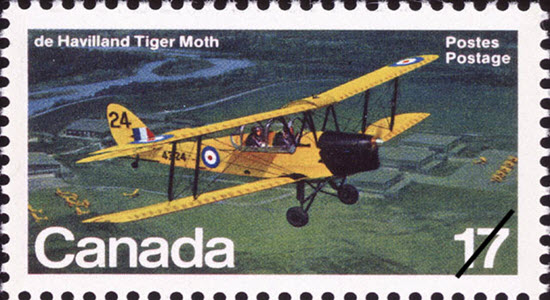 |
|
|
de Havilland Tiger Moth Stamp (issued 1981)
|
|
|
|
|
|
|
|
|
|
Dear Reader,
Welcome to the NetLetter, an Aviation based newsletter for Air Canada, TCA, CPAir, Canadian Airlines and all other Canadian based airlines that once graced the Canadian skies.
The NetLetter is published on the second and fourth weekend of each month. If you are interested in Canadian Aviation History, and vintage aviation photos, especially as it relates to Trans-Canada Air Lines, Air Canada, Canadian Airlines International and their constituent airlines, then we're sure you'll enjoy this newsletter.
Our website is located at www.thenetletter.net Please click the links below to visit our NetLetter Archives and for more info about the NetLetter.
Note: to unsubscribe or change your email address please scroll to the bottom of this email.
|
|
|
|
|
|
|

ACFN/NetLetter News
|
|
|
|
|
AC Life App - Followup to NetLetter #1374
 On September 6, 2017 Air Canada released a new App for Smartphones (called the AC Life App) that has been made available to Air Canada Employees and Retirees. This App is only available from the ACaeronet App Store at appstore.aircanada.com and is not available from Google Play (Android Devices) or the Apple Apps Store (Apple Devices). On September 6, 2017 Air Canada released a new App for Smartphones (called the AC Life App) that has been made available to Air Canada Employees and Retirees. This App is only available from the ACaeronet App Store at appstore.aircanada.com and is not available from Google Play (Android Devices) or the Apple Apps Store (Apple Devices).
There has been a lot of interest in this App along with the accompanying confusion on how to access and use it. To explain in more detail regarding the AC Life App we have compiled information from multiple sources to help those that wish to use this application. Please click on the link below to access this information.
|
|
|
|
|
|
|
 |
|

Women in Aviation
|
|
|
|
|
More on the female flight attendants started in
NetLetter nr 1374.
The cabin crew industry has undergone a raft of changes in its history, from a dizzying array of uniforms to an evolution of the exact specifications applicants must meet. A 1936 New York Times article described the ideal air hostess as "petite; weight 100 to 118 pounds; height 5 feet to 5 feet 4 inches; age 20 to 26 years. Add to that the rigid physical examination each must undergo four times every year, and you are assured of "the bloom that goes with perfect health."
Three decades later, in 1966, a New York Times classified ad for stewardesses at Eastern Air Lines listed these requirements: "A high school graduate, single (widows and divorcees with no children considered), 20 years of age (girls 19 1/2 may apply for future consideration). 5'2" but no more than 5'9", weight 105 to 135 in proportion to height and have at least 20/40 vision without glasses."
|
|
Current Common Requirements (2017)
Height and arm reach
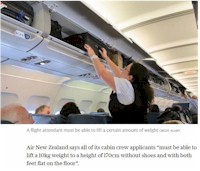 Most airlines today require flight attendants to be between 5’ 2" and 6’ 2" in height (without shoes), and sometimes slightly taller for male flight attendants. Some require a specific “arm reach” height, such as with Etihad which says cabin crew must be “able to reach 210cm (6' 10") without shoes”, while Emirates flight attendants must have an “arm reach of 212cm (6' 11") while standing on tiptoes”. British Airways' (BA) detailed “functionality” requirement says its flight attendants must have a “vertical functional reach of at least 2.01 meters (6' 7"), i.e. when you are standing with your feet flat against the floor, the fist on your dominant arm - when fully extended - is at least 6 feet 7 inches above the ground”. Most airlines today require flight attendants to be between 5’ 2" and 6’ 2" in height (without shoes), and sometimes slightly taller for male flight attendants. Some require a specific “arm reach” height, such as with Etihad which says cabin crew must be “able to reach 210cm (6' 10") without shoes”, while Emirates flight attendants must have an “arm reach of 212cm (6' 11") while standing on tiptoes”. British Airways' (BA) detailed “functionality” requirement says its flight attendants must have a “vertical functional reach of at least 2.01 meters (6' 7"), i.e. when you are standing with your feet flat against the floor, the fist on your dominant arm - when fully extended - is at least 6 feet 7 inches above the ground”.
Air New Zealand says all of its cabin crew applicants "must be able to lift 10kg (22 lbs) weight to a height of 170 cm (5' 6") without shoes and with both feet flat on the floor".
|
|
Weight and body mass index (BMI)
Airlines generally require flight attendants to be “in proportion to your height”. What might be considered a “healthy weight” may be determined by your body mass index, as seems to be the case with Czech Airlines.
“BMI is used to calculate weight – one’s body weight in kilograms is divided by the square of one’s body height in metres. BMI = body weight (kg) divided by square of height (m). A BMI = 19-24.9 is considered satisfactory”, the airline states. In 2016, Air India warned 600 of its 3,500 crew to lose weight within six months or risk being taken off flights. The airline announced plans to remove nearly 130 workers from cabin crew duty because their BMI levels remained above the prescribed limit.
The airline said that the “normal” BMI for an air hostess is between 18 and 22, “overweight” between 22 and 27, and “obese” for a value above 27. For male attendants the brackets were 18 to 25, 25 to 30, and above. The NHS says a “healthy” BMI is between 18.5 and 24.9.
(Source: Daily Telegraph)
More information at: www.telegraph.co.uk
|
|
|
 |
|

Air Canada News
|
|
|
|
|
Air Canada plans to begin Vancouver-Zurich on June 7, 2018 and Vancouver-Paris CDG on June 8, 2018 with B-787 service.
(Source: SpeedNews Septrmber 1, 2017)
|
|
|
Air Canada Invests In New Robots To Wash Aircraft
The airline will purchase three Aerowash robots to automate exterior aircraft cleaning. Operated by a wireless remote control, Aerowash automated washing robots can wash aircraft of any size using a gentle rotating brush on a mechanical arm.
(Source: MRO Network Daily 7/9/17)
|
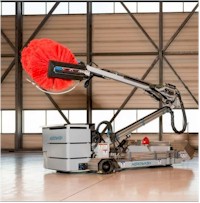 |
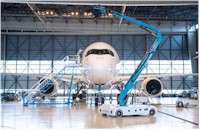 |
|
|
|
 |
|

Reader Submitted Photos
|
|
|
|
|
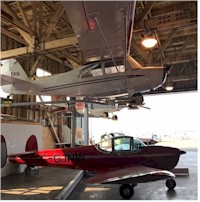 Laurie Pitcher sends this photo of Victoria Flying Club's method of utilizing hanger space. Pretty neat. Laurie Pitcher sends this photo of Victoria Flying Club's method of utilizing hanger space. Pretty neat.
Cheers Laurie.
|
|
|
Allan Gray has sent us these photos -
We were in Anchorage this July. While waiting for our flight to Vancouver, when what comes around the corner is this anniversary addition A319. C-FZUH ACF264 "beautiful".
|
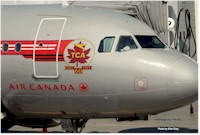
|
 |
|
|
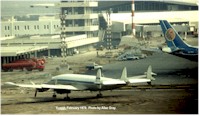 I was cleaning out some old slide photos and one of a Super Connie dated February 1979 came up. Checking my records, I see that the photo was taken in Kuwait. Follow this link for a complete history of this aircraft. www.conniesurvivors.com/N11SR I was cleaning out some old slide photos and one of a Super Connie dated February 1979 came up. Checking my records, I see that the photo was taken in Kuwait. Follow this link for a complete history of this aircraft. www.conniesurvivors.com/N11SR
More details are available at rzjets.com.
Regards, Allan Gray
|
|
|
 |
|
TCA/AC People Gallery

|
|
|
|
|
From the "Parts & Pieces" magazine issue dated December 1988.

How it all began -
Back in 1982 and 1983, a few people felt that the people working 6/3 shift were missing a lot of the company/work information that was available to other employees. It took some convincing that a newsletter might be one way of keeping everyone informed and more aware of Stores and its operation. The convincing worked and three YUL Stock keepers (Tony Virgona, Tarmo Saloranta and Bob Monks) had a discussion on the advantages of a newsletter dedicated to Stores Personnel.
They agreed among themselves that the idea was workable and tried it out on the boss. The idea was well received and permission was given "to try it out". It took almost two years and various people to cut through the odd piece of red tape, until finally everything was "go" and the first newsletter was produced. Many of the people were wary and opposed to what was perceived to be a "management mouthpiece". The Editors had hoped to have something good going and had to battle to prove exactly what our banner said:
"A NEWSLETTER FOR STORES PEOPLE -- BY STORES PEOPLE".
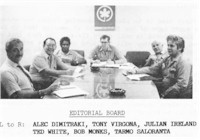 From a humble two-page beginning, with no pictures and without a name, it has evolved into a semi-professional publication without losing its original intent to provide everyone with a means of communication. Here is the first editorial board. From the left: Alec Dimitraki, Tony Virgona, Julian Ireland, Ted White, Bob Monks and Tarmo Saloranta. From a humble two-page beginning, with no pictures and without a name, it has evolved into a semi-professional publication without losing its original intent to provide everyone with a means of communication. Here is the first editorial board. From the left: Alec Dimitraki, Tony Virgona, Julian Ireland, Ted White, Bob Monks and Tarmo Saloranta.
|
|
|
From the issue dated January/February 1989,
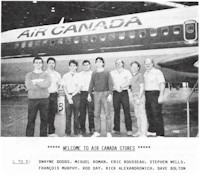 Here are a group of new hires – Here are a group of new hires –
From the left: Dwayne Dodds, Miguel Roman, Eric Rousseau, Stephen Wells, Francois Murphy, Rod Day, Rick Alexandrowich and Dave Bolton.
|
|
|
Romancing a code by Tony Virgona
Last October 1st, 1988, US Air got its new airline designator code.
From "AL" it switched to "US". Simple enough you say, but in effect it took the Washington based carrier 18 months of hassling, lobbying and uncountable miles of travel to get its new code. The designator code is assigned by IATA and is a strong symbol of the host airline. It appears on the Official Airlines Guide (OAG), on airline tickets and on computer screens, timetables and brochures. US Air was coded prior to October 1988 as "AL" from its old name Allegheny Airlines and it wanted desperately to get the code "US" which belonged to the U.S. Air Force's Military Airlift Command.
After much negotiation and lobbying with the government they were given the green light, but on condition they wrangled code "MC" for Military Airlift Command. Yes, you've guessed it. Code "MC" was already in use. It belonged to a minor airline, called Transtar, formerly Muse Air.
US Air's roving negotiating team contacted Transtar Airlines and were able to get it to give up their "MC" code, but once again, on condition that the US Air team got Transtar the "TS" code. One quick look at the OAG showed that code "TS" belonged to an outfit in Western Africa called Transport Aerien du Benin, aka T.A.B., a one-aircraft outfit. US Air's negotiating mission by now nicknamed "Romancing the Code" was quickly on its way to Africa.
Before serious bargaining even got underway T.A.B. folded and the code "TS" was free. Armed with code "TS" the -"Romancers of the Code" rushed to Transtar only to find this airline in its final hour and before long "MC" also became available. The U.S. Air Force happily received the code "MC" for its military airlift command and "US" joined the flying community officially as US Air.
Tony Virgona
|
|
|
From the “Horizons” magazine issue dated December 1981.
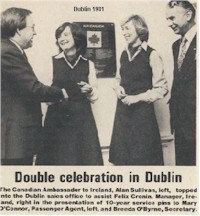 Alan Sullivan, the Canadian Ambassador to Ireland assisted Felix Cronin, Manager Ireland in presenting 10 year service pins to Mary O'Connor, Passenger Agent and Breeda O'Byrne, Secretary. Alan Sullivan, the Canadian Ambassador to Ireland assisted Felix Cronin, Manager Ireland in presenting 10 year service pins to Mary O'Connor, Passenger Agent and Breeda O'Byrne, Secretary.
In this photo from the left: Alan Sullivan, Mary O'Connor, Breeda O'Byrne and Felix Cronin.
|
|
|
Found in the "New Horizons" magazine issued October 30, 2004. (Used with permission)
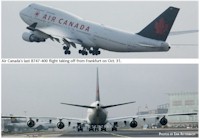 October 31, 2004 marked the end of an era at Air Canada – the last flight of the B747-400. The last of the all-passenger 747s were retired earlier. The remaining three of the distinctively-shaped airplanes flew as a “combi” for passengers and cargo. October 31, 2004 marked the end of an era at Air Canada – the last flight of the B747-400. The last of the all-passenger 747s were retired earlier. The remaining three of the distinctively-shaped airplanes flew as a “combi” for passengers and cargo.
One was parked in the Arizona desert at the end of October, the other two flew their last flights from Frankfurt to Montreal and Toronto Oct. 30 and 31 respectively. The Montreal flight continued on to Toronto as a Rapidair flight.
Those last two aircraft, FIN's 341 (C-GAGL) and 343 (C-GAGN), will be ferried to Tel Aviv in November where they will be modified for their new owners Air China. They will be turned into all-cargo planes – the seats will be removed, the stairs moved closer to the flight deck and the floors reinforced. The last revenue flight of the B747-400 was AC 873 between Frankfurt and Toronto on October 31.
|
|
|
 |
|

Alan's Space
|
|
|
|
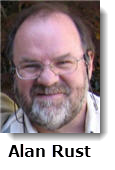 Air New Zealand "Flight with a Heart" Air New Zealand "Flight with a Heart"
On 3 September, 2017 Air New Zealand took 50 children with critical medical conditions such as cancer and heart disease, and their caregivers, on the flight of a lifetime over New Zealand. The nearly three hour flight took the aircraft and its passengers on a 440 km long and 483 km wide heart-shaped journey across New Zealand.
Departing Auckland, the Air New Zealand 787-9 headed south, beginning its heart-shaped path west of Taharo. During the flight, MCs Adam and Eve from The Adam and Eve Show entertained the kids on board. Prior to departure the children enjoyed a waiata performed by Te Kura Kaupapa Māori ā-Rohe o Māngere school.
The Flight Radar site at www.flightradar24.com partnered with Air New Zealand to help reveal the flight path on Facebook Live as the flight made its way over New Zealand. The exact flight plan was kept secret to ensure the finished path would be a surprise for the guests on board and for those watching at home.
For full story see: www.flightradar24.com/blog/air-new-zealands-heartfelt-koru-care-flight

|
|
 |
|
CPAir, Canadi>n People Gallery
|
|
|
|
| October 1961, Calgary was included as a traffic stop on the Polar route and in December 1962 as a traffic stop on the Latin American service. |
|
|
MACKENZIE AIR SERVICE, LTD.: Canada (1933-1942).
Inaugurates operations on January 1, 1933 by flying fresh vegetables from Edmonton to the Eldorado Mines at Great Bear Lake. The route to Great Bear Lake is continued. During 1938, scheduled flights are undertaken linking the company’s base with Port Radium via Yellowknife and Gordon Lake.
During the spring of 1941, the carrier is purchased by Canadian Pacific Railway and is merged with the Canadian Airways, Ltd. service from Edmonton to Prince Albert under the marketing title United Air Services, Ltd. in July. Six months later, on January 30, 1942, Mackenzie is one of several air transport companies merged to form Canadian Pacific Air Lines, Ltd.
(Source: worldhistory.biz)
Below we have a 1938 timetable issued June 1st and effective November 1st, 1940.
(From collection of Bjorn Larsson.)
|
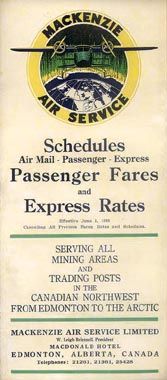 |
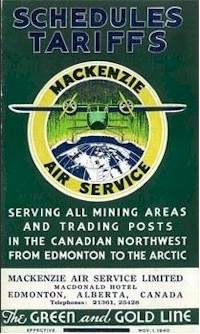 |
|
| On December 4th, 1953, a CPA DC-6B arrived at Vancouver from Tokyo becoming the first plane to fly non-stop believed, at the time, to be the longest commercial airline passenger flight of 7,723 kms. Captain James Black was in command. (Source: Vancouver Sun) |
|
|
 |
|
 Wayne's Wings Wayne's Wings
|
|
|
|
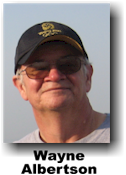 Air Lines, Airlines or Airways? Air Lines, Airlines or Airways?
Terry Baker and Ken Pickford of the NetLetter team share a passion for the English language and the use of proper grammar. With all due respect to both gentlemen, I would like mention (with humour intended) that we should keep one important fact in mind. This is English!
The actual origins of the language seem to be a continuing subject of debate but we may say that it has been spread all over the globe and evolved differently depending on the region. Spelling and pronunciation may vary slightly between regions but slang almost creates a new unique language even within a single country.
Today’s technology has turned corporation names into verbs (Google it) and acronyms into nouns (RAM, LASER, RADAR, MODEM etc.). However, I think that one of the most fascinating aspects of language is the constant addition of compound words derived from the formation of new industries. 
This brings me to the phrase “Air Line” from which the noun “Airline” was derived. In the early days of the industry, “Air Line(s)” would have been used to distinguish this form of transportation from a “Cruise Line” or “Rail(way/road) Line” and referred to the actual routes. Trans-Canada Air Lines and Canadian Pacific Air Lines were named before the word “Airline” became part of the language. Since the addition of “Airways” , the three terms have been interchanged liberally; to the annoyance of many.
“Airline” is defined as “an organization providing a regular public service of air transportation on one or more routes”, in one quick Google search. If you have a week or two on your hands with absolutely nothing else to do, I suggest that you do a Google search for “Air Lines, Airlines or Airways” and settle in. Or, check out www.airliners.net for a condensed version of the debate.
|
|
 |
|

Reader's Feedback
|
|
|
|
German Aero Engine update:
Colin Grant has kindly agreed to write up the following item explaining all about the mysterious aero engines which turned up in the Cargo Department at LHR.
The mysterious case of the two very old and very damaged aircraft engines; mysterious for us that is, as a bunch of young mechanics arriving for work that morning in the mid-seventies, they were a complete mystery. No information was forthcoming regarding why they were plonked on pallets in the middle of our otherwise immaculate workshop, looking in a very sad state, but a closer inspection was a must.
 Yes, they were German, V-12 - Twelve-cylinder supercharged liquid-cooled 60-degree inverted V piston aircraft engines. They were inverted (mounted upside down unlike a car engine), supercharged and fuel injected. The name plate told us they were Junkers Jumo engines from 1939. We soon indulged in a much closer inspection - our usual work would have to wait that day. Nobody knew anything about them or why they were there and what's more, nobody seemed to care. They were beautiful pieces of kit, made to a remarkably high standard; remember, we were still driving Morris Marinas and such like at the time. They were very bent, with some parts strangely missing, magnetos that gave the plugs their spark with all their internals and drives as they should be, but no bodies or casings, the same with the rocker covers, all the bolts that held them on, even with their small tab washers still in place, but no covers. Yes, they were German, V-12 - Twelve-cylinder supercharged liquid-cooled 60-degree inverted V piston aircraft engines. They were inverted (mounted upside down unlike a car engine), supercharged and fuel injected. The name plate told us they were Junkers Jumo engines from 1939. We soon indulged in a much closer inspection - our usual work would have to wait that day. Nobody knew anything about them or why they were there and what's more, nobody seemed to care. They were beautiful pieces of kit, made to a remarkably high standard; remember, we were still driving Morris Marinas and such like at the time. They were very bent, with some parts strangely missing, magnetos that gave the plugs their spark with all their internals and drives as they should be, but no bodies or casings, the same with the rocker covers, all the bolts that held them on, even with their small tab washers still in place, but no covers.
A debate ensued, fueled with large mugs of tea, as usual. The penny finally dropped - these parts had been made from ultra-lightweight magnesium and had corroded completely away, without a trace of them left. Clearly these engines had been under the ground for a long time, [thirty five years as it turned out], a spark plug or two were removed and tested in our Champion spark plug test machine, their platinum tips still gave a beautiful spark. Further inspection revealed that the fuel injectors were in perfect working order, the connecting rods [visible through a large bullet hole] were still free on the crankshaft, despite this being bent like a banana. At last our dismantling caused a stir and a manager appeared to halt proceedings and finally explain the situation.
(Source: September issue Newsletter from LHR Pionairs)
(To be continued in NetLetter nr 1376 – eds)
|
|
 |
|

Odds and Ends
|
|
|
|
|
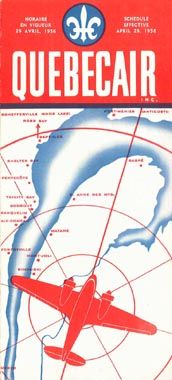 1956 Quebecair timetable effective April 29th. (Bjorn Larsson collection) 1956 Quebecair timetable effective April 29th. (Bjorn Larsson collection)
Quebecair began as Rimouski Airlines in 1947 and flew under that name until it merged with Gulf Aviation in 1953 under the name Quebec-Air.
The aircraft in operation at the time were the Beech 18, the de Havilland Canada DHC-2 Beaver and the Douglas DC-3. Operations were mainly based in Quebec and Montreal was added in 1957.
Eventually the latter city became the operating base for Quebecair. During the 1960s, the company took over various other airlines, namely Matane Air Service and Northern Wings in 1965, Fecteau Air Service in 1968, and Royale Air in 1969. The increase in operations brought the introduction of the first jet aircraft, the British Aircraft Corporation BAC One-Eleven, which were put into use in 1969.
(Source: wikipedia)
|
|
| The forgotten Trethewey Air Field.
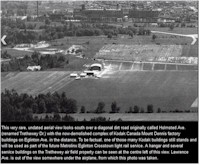 De Lesseps Field was a small, but important airfield in early aviation in Toronto. De Lesseps Field was a small, but important airfield in early aviation in Toronto.
Opened sometime before 1910, an airfield was created from three farms by engineer William G. Trethewey (1865–1926). The airfield was located near present-day Hearst Circle and the Wishbone on a 600 acres (2.4 km2) site in York Township (just outside Weston, Ontario).
The grassy airfield was later used by French aviator Count Jacques Benjamin de Lesseps (1883–1927) and later renamed after him. The property remained in the hands of the Trethewey family after the death of Trethewey, but in 1928 Trethewey's son Fred sold it to airline Skyways Limited.
De Havilland Canada established their first home here in 1928 (building a small hangar) to build Gipsy Moth and Tiger Moth aircraft, but left for Downsview in 1929.
(Source: wikipedia.org and Toronto-Sun)
There was a Trethewey Airfield Plaque Dedication ceremony on July 15, 2017. The Canadian Aviation Historical Society had a great writeup of the event in their July Newsletter. You can view this newsletter by following this link.

|
|
|
The Canadian Aviation Historical Society (CAHS) asked their members to recommend titles of aviation books to celebrate "Canada 150".
 Click the icon for a list of the 201 titles available. Click the icon for a list of the 201 titles available.
|
|
|
 |
|

Terry's Trivia and Travel Tips
|
|
|
|
|
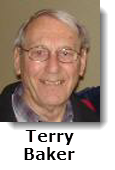 The Etihad Airways Sports and Social Club is organizing the 4th Etihad Airways World Aviation Football Cup from November 15 to 18, 2017 in Abu Dhabi. The aim of the tournament is to unite teams from all over the world in a friendly and fun atmosphere being organized under the theme “Tolerance is the Road to Happiness.” The Etihad Airways Sports and Social Club is organizing the 4th Etihad Airways World Aviation Football Cup from November 15 to 18, 2017 in Abu Dhabi. The aim of the tournament is to unite teams from all over the world in a friendly and fun atmosphere being organized under the theme “Tolerance is the Road to Happiness.”
Interested participants can e-mail This email address is being protected from spambots. You need JavaScript enabled to view it. for more information and the registration process.
|
|
|
UK LCC easyJet is rolling out a new “Hands Free” service, where passengers can pay £4 ($5) to leave their hand luggage at check-in and receive priority boarding.
(Source: AWT Daily News 31/8/17)
|
|
|
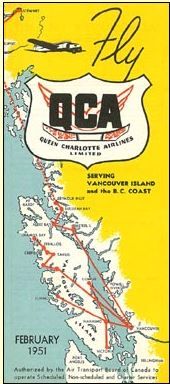 Queen Charlotte Airlines was a Canadian airline founded by Jim Spilsbury that operated on the West Coast of Canada from 1946 to 1955, after which it was sold to Pacific Western Airlines. Though the airline grew out of a bush flying operation, it became the third largest airline in Canada. The book "The Accidental Airline" by Jim Spilsbury and Howard White tells the story of the QCA. Queen Charlotte Airlines was a Canadian airline founded by Jim Spilsbury that operated on the West Coast of Canada from 1946 to 1955, after which it was sold to Pacific Western Airlines. Though the airline grew out of a bush flying operation, it became the third largest airline in Canada. The book "The Accidental Airline" by Jim Spilsbury and Howard White tells the story of the QCA.
This timetable issued February 1951. (collection of Bjorn Larsson)
(Source: Wikipedia)
|
|
|
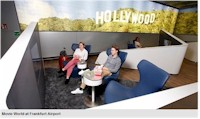 Germany’s Frankfurt Airport now offers a selection of movies and gaming activities for waiting passengers in Piers A and Z in Terminal 1. Both are free services. Germany’s Frankfurt Airport now offers a selection of movies and gaming activities for waiting passengers in Piers A and Z in Terminal 1. Both are free services.
Frankfurt operator Fraport said “Movie World” enables passengers to sit on “comfortable couches for up to three persons" which are arranged in front of TV screens, just like at home. They are placed in niches for added privacy.
Plus, the floor is covered with carpeting: although this is an unusual sight at an airport, it results in a cozier, more intimate atmosphere.” The films are played on demand. The two Movie World areas in Terminal 1 can accommodate 22 persons in eight separate TV niches.
(Source: atwonline)
|
|
|
 |
|

Smileys
|
|
|
|
Vern Swerdfeger sends us this url –
Hilarious Southwest Airlines Flight Attendant Announcement
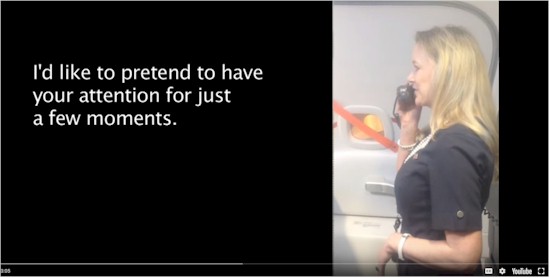 Click Here to learn more about Flight Attendant Marty Cobb Click Here to learn more about Flight Attendant Marty Cobb
|
|
 |
|
|
|
|
 |
|
Terry Baker | Alan Rust | Wayne Albertson
Ken Pickford (missing from photo)
NetLetter Staff for 2017
(you can read our bios at www.thenetletter.net/history)
|
|
|
|
|
|
Subscription Management
 Updating your profile: Updating your profile:
If you would like to update your email address or change/update the name that appears within the NetLetter then please click on the following link >>> Modify your Subscription
We presently have the following info in your profile:
First Name:
Last Name:
Email:
Province/State:
Country:
 Unsubscribe - We'd hate to see you go, but don't want you to receive email you don't want to read. Please click here to unsubscribe. Unsubscribe - We'd hate to see you go, but don't want you to receive email you don't want to read. Please click here to unsubscribe.
|
|
|
|
|
|
|
E&OE - (errors and omissions excepted) - The historical information as well as any other information provided in the "NetLetter" is subject to correction and may have changed over time. We do publish corrections (and correct the original article) when this is brought to our attention.
Disclaimer: Please note that neither the NetLetter or the ACFamily Network necessarily endorse any airline related or other "deals" that we provide for our readers. We would be interested in any feedback (good or bad) when using these companies though and will report the results here. We do not (normally) receive any compensation from any companies that we post in our newsletters. If we do receive a donation or other compensation, it will be indicated as a sponsored article or link.
|
|
|
|
|


























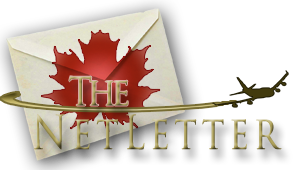


















 Wayne's Wings
Wayne's Wings









 Updating your profile:
Updating your profile:  Unsubscribe - We'd hate to see you go, but don't want you to receive email you don't want to read. Please
Unsubscribe - We'd hate to see you go, but don't want you to receive email you don't want to read. Please